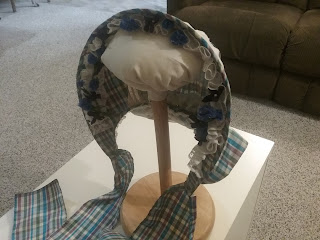Remember those silk points from the lace bend round? Armed with those, a replica schnapps flask, a copy of The Typical Tudor, and a whole bunch of scrap fabric, I decided to embark on my most luridly-colored project of the year. So far.
Step 1) Tracing the Pattern.
To fit the flask (and extra padding around it), I cut a muslin mock-up of the codpiece with very generous seam allowances, then pinned out the excess. The result was a that I ended up extending the side edges of the codpiece pieces by 1/4" (leaving the overall length the same).
With the new pattern, I then cut out all the requisite silk fabric, linen lining, and wool padding pieces called for in the pattern. Additional, I cut a linen interlining and gathered some smaller wool scraps for padding out the flask.
 |
Materials all assembled.
|
Step 2) Initial construction.
I didn't get a good picture of this step, but I started by decorating the outside silk piece with optional slashes, basting in the pull-throughs, and then joining the two silk halves along the center seam. The interlining also was also pieced at this time.
Step 3) Padding.
To get the proper mid-16th century shape, the codpiece needs padding. To allow room for the flask, I made an abbreviated version of the prescribed pattern (using 2 thin and 1 thick piece layer of wool) to give a smooth line to the fabric. I set this into the fashion fabric, added the flask, then started cutting small pieces of wool to fill in the gaps.
 |
Adding extra layers to surround the flask's neck and support the base.
|
 |
Graduated circles to fill in the hollow under the flask.
|
 |
Padding ready to be basted in place.
|
Step 4) Interlining.
With the wool padding in place, I attached the linen interlining. The idea was to give a smooth interior for the flask, so the interlining was cut to match the exterior; it's joined by stitching all around the outside edges, leaving the wool padding sandwiched between the silk and linen layers.
 |
Flask in the finished interior.
|
Step 4) Lining and binding.
Next up, I need to add the final backing, which makes the other half of the actual pouch for the flask. It's also joined to the front along all three sides, those seams being then covered by a self-fabric bias binding. For the top, I hemmed the lining and bound the exterior separately, joining them with some blind stitching just near the corners.
Step 5) Eyelets.
To attach the points, I made a pair of eyelets in each of the upper two corners, going through all the silk and linen layers. This, of course, if how I discovered that the aiglets I used are a bit bigger than either of my fabric awls. Combined with the green silk having a non-woven backing (giving the fabric great body, but being bad for piercing), these four eyelets were basically the worst part of this project. Once done, the points were put through, and tied in jaunty half-bows.
 |
|
|
|
|
|
|
|
|
|
|
|
|
|
|
|
|
|
|
|
|
|
|
|
|
|
|
|
|
|
| Voila: one slashed silk codpiece with a hidden flask. |
|
|
|
Conclusion: As a decorative gag gift, I'm quite happy with how this project turned out, and expect the recipient to come up with an amusing story about confiscating it from one of the Landsknechts (if not something more outlandish). I'm not certain this codpiece could actually work as worn, given the weight distribution and discomfort of the glass poking the wearer. If firming sewn along the side/bottom, I do think it could be attached to hose, though I would be concerned about the top gaping, possibly necessitating a third point at the center top.
If making again, I'd add more padding to the back lining, possibly increasing the overall size of the item to ensure there's plenty of space to pad the back with enough material to get a smooth finish despite the rounded flask. If intended for wear, I'd want to both make up some regular codpieces for practice, and also test the aforementioned fit issues, with feedback from the wearer.
That being said, if any of my doublet-and-hose-wearing acquaintances are interested, I would like to experiment with making a comfortable, wearable, concealed flask codpiece.

























